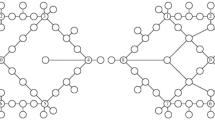Abstract
We consider a route in a rectilinear grid communications network and compute the ratio of the additional capacity per tandem node required to make the route immune to a single tandem node failure (which causes all arcs incident to the node to fail), divided by the additional capacity per arc required to make the route immune to a single arc failure. For any route satisfying a mild assumption, we prove the ratio is between 1 and 4/3. For random routes, we show that the expected value of the ratio is 10/9 for routes using 2 arcs, 202/189 for routes using 3 arcs, and has the limit (as the number of arcs increases to infinity) of 7/6. The theoretical results are in close agreement with empirical results, using a network design algorithm, for large data communications networks.
Similar content being viewed by others
References
A. Balakrishnan, T.L. Magnanti and P. Mirchandani, Designing hierarchical survivable networks, Operations Research 46(1) (1998) 116-136.
R. Bhandari, Survivable Networks: Algorithms for Diverse Routing (Kluwer Academic, Boston, MA, 1999).
F.T. Boesch, Synthesis of reliable networks - A survey, IEEE Transactions on Reliability 35(3) (1986) 240-246.
R.H. Cardwell, C.L. Monma and T.-H. Wu, Computer-aided design procedures for survivable fiber optic networks, IEEE Journal on Selected Areas in Communications 7(8) (1989) 1188-1197.
F.R.K. Chung, Spectral Graph Theory, Regional Conference Series in Mathematics, Vol. 92 (Amer. Math. Soc., Providence, RI, 1997).
F.R.K. Chung, V. Faber and T.A. Manteuffel, An upper bound on the diameter of a graph from eigen-values associated with its Laplacian, SIAM Journal on Discrete Mathematics 7(3) (1994) 443-457.
E. Çinlar, Introduction to Stochastic Processes (Prentice-Hall, Englewood Cliffs, NJ, 1975).
L.W. Clarke and G. Anandalingam, Optimal design of survivable LAN-LAN networks, in: IEEE Internat. Conf. on Systems, Man, and Cybernetics (1990) pp. 293-297.
D.M. Cvetkovic, M. Doob and H. Sachs, Spectra of Graphs (Academic Press, New York, 1979).
G. Dahl, The design of survivable directed networks, Telecommunication Systems 2(4) (1994) 349-377.
L. Davis, D. Orvosh, A. Cox and Y. Qiu, A genetic algorithm for survivable network design, in: Proc. of the 5th Internat. Conf. on Genetic Algorithms (Morgan Kaufman, San Mateo, CA, 1993) pp. 408-415.
A. De Jongh, M. Gendreau and M. Labbé, Finding disjoint routes in telecommunications networks with two technologies, Operations Research 47(1) (1999) 81-92.
H. Frank and I. Frisch, Communication, Transmission, and Transportation Networks (Addison-Wesley, Reading, MA, 1971).
M. Grotschel, C.L. Monma and M. Stoer, Computational results with a cutting plane algorithm for designing communications networks with low-connectivity constraints, Operations Research 40(2) (1992) 309-330.
M. Grotschel, C.L. Monma and M. Stoer, Design of survivable networks, in: Handbook in Operations Research and Management Science: Networks (Bellcore, Morristown, NJ, 1993).
Y. Kajitani and S. Ueno, The minimum augmentation of a directed tree to a k-edge-connected directed graph, Networks 16 (1986) 181-197.
R. Koch, Private communication (1997).
D. Medhi, A unified framework for survivable telecommunications network design, in: SUPER-COMM/ Internat. Conf. on Communications (1992) pp. 411-415.
B. Mohar, Eigenvalues, diameter, and mean distance in graphs, Graphs and Combinatorics (7) (1991) 53-64.
C.L. Monma and D.F. Shallcross, Methods for designing communications networks with certain two-connected survivability constraints, Operations Research 37(4) (1989) 531-541.
S. Soni, R. Gupta and H. Pirkul, Survivable network design: The state of the art, Information Systems Frontiers 1(3) (1999) 303-315.
K. Steiglitz, P. Weiner and K.J. Kleitman, The design of minimum-cost survivable networks, IEEE Transactions on Circuit Theory 16(4) (1969) 455-460.
J.W. Surballe and R.E. Tarjan, A quick method for finding shortest pairs of disjoint paths, Networks 14 (1984) 325-336.
K. Yamato, M. Murata, S. Nishio and H. Mayahara, Design algorithm for survival of fiber optic networks, Electronics and Communications in Japan: Part 1 75(8) (1992) 1-15.
Author information
Authors and Affiliations
Rights and permissions
About this article
Cite this article
Rosenberg, E. Capacity Requirements for Node and Arc Survivable Networks. Telecommunication Systems 20, 107–131 (2002). https://doi.org/10.1023/A:1015493417623
Issue Date:
DOI: https://doi.org/10.1023/A:1015493417623




